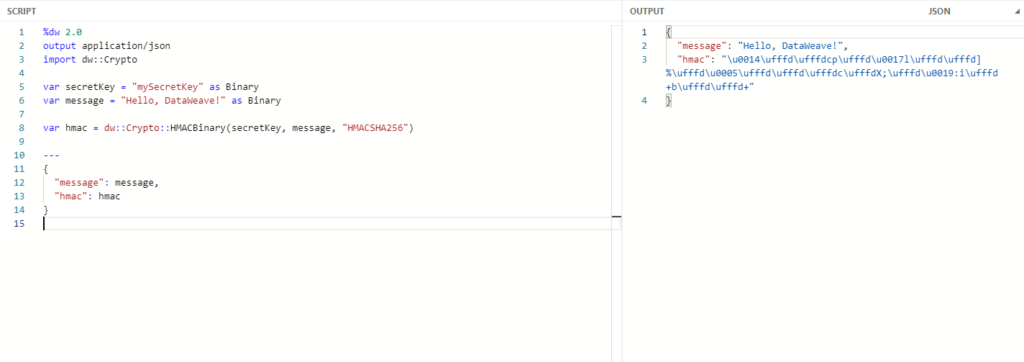Harnessing the Power of DataWeave Crypto Functions: A Comprehensive Guide to HMACBinary
Introduction:
Welcome to our blog, where we explore the fascinating world of DataWeave and dive into one of its powerful features: the HMACBinary crypto function. In this article, we’ll provide an in-depth understanding of HMACBinary, its applications, and guide you through examples to help you leverage its capabilities effectively. So let’s get started!
What is HMACBinary?
HMACBinary is a cryptographic function provided by DataWeave, a powerful transformation language used in MuleSoft’s Anypoint Platform. HMACBinary stands for Hash-based Message Authentication Code Binary and is primarily used for message integrity checks and verification.
HMACBinary Function in DataWeave 2.4:
DataWeave 2.4 introduced the HMACBinary function to enable developers to generate an HMAC using a binary format. It provides a secure way to authenticate data using a shared secret key. HMACBinary takes two inputs: the secret key and the data to be authenticated, and produces an HMACBinary output.
The HMACBinary function requires the following parameters:
secretKey: The shared secret key used for authentication, provided as binary.
data: The data to be authenticated, also provided as binary.
algorithm: The algorithm used for HMAC generation, such as MD5, SHA1, SHA256, etc.
Note: When it comes to the hashing algorithm, the default option is HmacSHA1. However, the valid values vary depending on the version of JDK you are using. If you are working with JDK 8 or JDK 11, you can choose from a range of valid algorithms including HmacMD5, HmacSHA1, HmacSHA224, HmacSHA256, HmacSHA384, and HmacSHA512. In the case of JDK 11, you also have the additional options of HmacSHA512/224 and HmacSHA512/256. These algorithms provide secure and efficient hashing functionalities for your applications, ensuring data integrity and protection.
Example Usage:
Let’s illustrate the usage of HMACBinary with a practical example. Suppose we have a secret key “mySecretKey” and a message “Hello, DataWeave!” that needs to be authenticated using the SHA256 algorithm.
%dw 2.0
output application/json
import dw::Crypto
var secretKey = "mySecretKey" as Binary
var message = "Hello, DataWeave!" as Binary
var hmac = dw::Crypto::HMACBinary(secretKey, message, "HMACSHA256")
---
{
"message": message,
"hmac": hmac
}
In the above example, we convert the secret key and message into binary format using the as Binary operator. Then we pass these binary inputs along with the chosen algorithm to the HMACBinary function. The resulting HMAC is stored in the hmac variable.
Applications of HMACBinary:
HMACBinary has various applications in secure data communication, authentication, and verification. Here are a few scenarios where HMACBinary can be utilized:
- Secure API Communication: HMACBinary can be used to authenticate API requests by generating an HMAC for each request and verifying it on the receiving end. This ensures the integrity and authenticity of the data exchanged.
- Message Validation: When receiving data from an external source, HMACBinary can be employed to validate the integrity of the received message, ensuring that it hasn’t been tampered with during transmission.
- Token-Based Authentication: HMACBinary can be used in conjunction with tokens to enhance the security of authentication mechanisms. By generating an HMAC using the token and verifying it on the server side, potential tampering or unauthorized access can be detected.
Frequently Asked Questions (FAQs):
Q1. Is HMACBinary secure?
.Ans: Yes, HMACBinary is a secure cryptographic function used for message authentication. However, it’s essential to choose a strong secret key and a secure hashing algorithm to maximize security.
Q2. Can HMACBinary be used in other programming languages?
Ans: HMACBinary is a feature specific to MuleSoft’s DataWeave language. However, other programming languages provide similar HMAC functions that you can utilize for message authentication.
Q3. Can I change the hashing algorithm in HMACBinary?
Ans: Yes, you can choose from various hashing algorithms supported by HMACBinary, such as MD5, SHA1, SHA256, etc. Selecting the appropriate algorithm depends on your specific security requirements.
Q4. How can I convert a string to a binary in DataWeave?
Ans: To convert a string to binary format in DataWeave, you can use the as Binary operator. For example, "myString" as Binary.
Remember, secure communication is the key to building reliable and trustworthy systems, and HMACBinary can be an invaluable function in achieving that goal.
